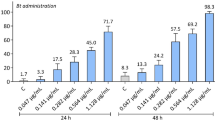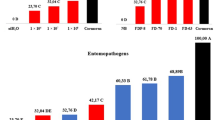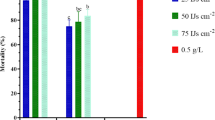Abstract
The Box tree pyralid Cydalima perspectalis Walker (Lepidoptera: Crambidae) is one of the accidentally introduced organisms that became invasive and established in Europe within a few years. Thus, eco-friendly preparations are required, which should be accessible, affordable, easy usable and suitable for the application in private and public areas. Therefore, the effects of the plant extract formulation NeemAzal®-T/S (active ingredient Azadirachtin A) and the commercial preparation Nemastar® (entomopathogenic nematode species Steinernema carpocapsae) were investigated on C. perspectalis larvae in laboratory bioassays and field trials. When NeemAzal®-T/S-treated leaf discs were consumed by larvae in the laboratory, a significant effect on mortality and feeding activity was noted after 14 days of exposure. At this time, 47–62% of the larvae had already died and less than 10% of larvae were still feeding. Application of different S. carpocapsae suspensions (10–200 EPN/100 μl, i.e. per larva) demonstrated a high susceptibility of both tested larval instars (2nd: 10–75% and 4th: 45–100% mortality). In field trials neither the application of Nemastar® nor the use of NeemAzal®-T/S caused mortality rates comparable to those generated by the treatment with plant protection products based on Bacillus thuringiensis. In conclusion, there is a higher variability in terms of the effects of the investigated agents compared to the constant effectiveness of B. thuringiensis. But their use would be possible if individual feeding damage and proper surveillance will be considered in order to be capable of repeating the application timely and a combination with further measures ought to take place.






Similar content being viewed by others
References
Arthurs S, Heinz KM, Prasifka JR (2004) An analysis of using entomopathogenic nematodes against above-ground pests. Bull Entomol Res 94(04):297–306
Bastidas B, Portillo E, San-Blas E (2014) Size does matter: the life cycle of Steinernema spp. in micro-insect hosts. J Invertebr Pathol 121:46–55
Benelli G, Canale A, Toniolo C, Higuchi A, Murugan K, Pavela R, Nicoletti M (2017) Neem (Azadirachta indica): towards the ideal insecticide? Nat Prod Res 31(4):369–386
Burges HD (1982) Control of insects by bacteria. Parasitology 84(4):79–117
Choo HY, Kaya HK, Lee SM, Kim TO, Kim JB (1991) Laboratory evaluation of enthomopathogenic nematodes Steinernema carpocapsae and Heterorhabditis bacteriophora against some forest insect pests. Korean J Appl Entomol 30(4):227–232
Dammini Premachandra WTS, Borgemeister C, Poehling H-M (2005) Effects of Neem and Spinosad on Ceratothripoides claratris (Thysanoptera: Thripidae), an important vegetable pest in Thailand, under laboratory and greenhouse conditions. J Econ Entomol 98(2):438–448
Efil L, Ozgen I, Yardim EN (2005) Effects of a commercial Neem insecticide (NeemAzalTM-T/S) on early and late developmental stages of the Beet armyworm Spodoptera exiqua (Hübner) (Lepidoptera: Noctuidae). PJBS 8(4):520–526
Erler F, Cetin H, Saribasak H, Serttas A (2010) Laboratory and field evaluations of some botanical pesticides against the cedar leaf moth, Acleris undulana. J Pest Sci 83(3):265–272
Glazer I (1992) Survival and efficacy of Steinernema carpocapsae in an exposed environment. Biocontrol Sci Technol 2(2):101–107
Glazer I, Lewis EE (2000) Bioassays of entomopathogenic nematodes. In: Navon A, Ascher KRS (eds) Bioassays of entomopathogenic microbes and nematodes. CAB International (CABI Publishing), Wallingford 2000, pp. 234
Heckel DG, Gahan LJ, Baxter SW, Zhao JZ, Shelton AM, Gould F, Tabashnik BE (2007) The diversity of Bt resistance genes in species of Lepidoptera. J Invertebr Pathol 95(3):192–197
Isman MB (2006) Botanical insecticides, deterrents, and repellents in modern agriculture and an increasingly regulated world. Annu Rev Entomol 51:45–66
John R, Schumacher J (2013) Der Buchsbaum-Zünsler (Cydalima perspectalis) im Grenzach-Wyhlener Buchswald—Invasionschronik und Monitoringergebnisse [The Box-Tree Pyralid (Cydalima perspectalis) in the Box-Tree Forest of Grenzach-Whylen]. Gesunde Pflanzen 65(1):1–6
Kang J, Huang F, Onstad DW (2014) Modeling evolution of resistance of sugarcane borer (Lepidoptera: Crambidae) to transgenic Bt corn. Environ Entomol 43(4):1084–1104
Kaya HK, Gaugler R (1998) Entomopathogenic Nematodes. Annu Rev Entomol 38:181–206
Leuthardt FLG (2013) Distribution, life history, food choice and chemical ecology of the box-tree pyralid Cydalima perspectalis. Dissertation, University of Basel
Nacambo S, Leuthardt FLG, Wan H, Li H, Haye T, Baur B et al (2014) Development characteristics of the box-tree moth Cydalima perspectalis and its potential distribution in Europe. J Appl Entomol 138(1–2):14–26
Oberdorfer E, Schwabe A, Müller T (2001) Pflanzensoziologische Exkursionsflora für Deutschland und angrenzende Gebiete. Eugen Ulmer, Stuttgart
Schmutterer H (1990) Properties and potential of natural pesticides from the neem tree, Azadirachta indica. Annu Rev Entomol 35:271–297
Schmutterer H, Huber J (2005) Natürliche Schädlingsbekämpfungsmittel. Eugen Ulmer GmbH & Co, Germany
Schnepf E, Crickmore N, van Rie J, Lereclus D, Baum J, Feitelson J et al (1998) Bacillus thuringiensis and its pesticidal crystal proteins. Microbiol Mol Biol Rev 62(3):775–806
Shannag HK, Capinera JL (1995) Evaluation of entomopathogenic nematode species for the control of Melonworm (Lepidoptera: Pyralidae). Environ Entomol 24(1):143–148
Smits PH (1996) Post-application persistence of entomopathogenic nematodes. Biocontrol Sci Technol 6(3):379–388
Unruh TR, Lacey LA (2001) Control of codling moth, Cydia pomonella (Lepidoptera: Tortricidae), with steinernema carpocapsae: effects of supplemental wetting and pupation site on infection rate. Biol Control 20(1):48–56
van Trier H, Hermans D (2007) Buchs. Eugen Ulmer, Stuttgart
Walker F (1859) Part XVIII pyralides—list of specimens of lepidopterous insects in the collection of the British Museum (Vol. 18, pp. 509-798). London: British Museum (Natural History), Department of Zoology
Wan H, Haye T, Kenis M, Nacambo S, Xu H, Zhang F, Li H (2014) Biology and natural enemies of Cydalima perspectalis in Asia: is there biological control potential in Europe? J Appl Entomol 138(10):715–722
Williamson M, Fitter A (1996a) The characters of successful invaders. Biol Conserv 78:163–170
Williamson M, Fitter A (1996b) The varying success of invaders. Ecology 77(6):1661–1666
Acknowledgements
We would like to express our gratitude towards the Arthur and Aenne Feindt-Foundation (Hamburg), for the generous support of this work as a part of the project “Development of friendly methods for monitoring and regulating the Box tree pyralid, Cydalima perspectalis (Lepidoptera: Crambidae), an invasive pest in ornamentals”.
Author information
Authors and Affiliations
Corresponding author
Ethics declarations
Conflict of interest
The authors declare that they have no conflict of interest.
Rights and permissions
About this article
Cite this article
Göttig, S., Herz, A. Susceptibility of the Box tree pyralid Cydalima perspectalis Walker (Lepidoptera: Crambidae) to potential biological control agents Neem (NeemAzal®-T/S) and entomopathogenic nematodes (Nemastar®) assessed in laboratory bioassays and field trials. J Plant Dis Prot 125, 365–375 (2018). https://doi.org/10.1007/s41348-018-0154-8
Received:
Accepted:
Published:
Issue Date:
DOI: https://doi.org/10.1007/s41348-018-0154-8




